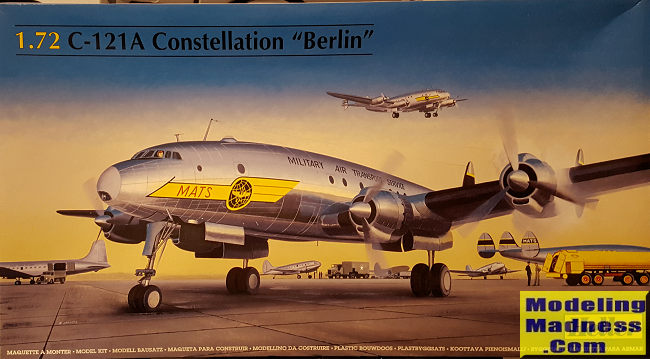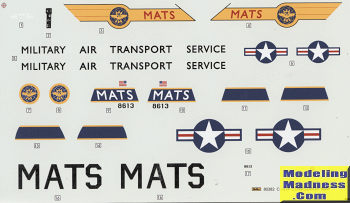
Heller 1/72 C-121A Constellation "Berlin"
| KIT #: | 80382 |
| PRICE: | |
| DECALS: | One option |
| REVIEWER: | Scott Van Aken |
| NOTES: | 1999 release |

| HISTORY |
The Lockheed Constellation ("Connie") is a propeller-driven, four-engined airliner built by Lockheed Corporation starting in 1943. The Constellation series was the first pressurized-cabin civil airliner series to go into widespread use. Its pressurized cabin enabled commercial passengers to fly well above most bad weather for the first time, thus significantly improving the general safety and ease of air travel.
Several different models of the Constellation series were produced, although they all featured the distinctive triple-tail and dolphin-shaped fuselage. Most were powered by four 18-cylinder Wright R-3350 Duplex-Cyclones. In total, 856 were produced between 1943 and 1958 at Lockheed's plant in Burbank, California, and used as both a civil airliner and as a military and civilian cargo transport. Among their famous uses was during the Berlin and the Biafran airlifts. Three served as the presidential aircraft for Dwight D. Eisenhower, one of which is featured at the National Museum of the United States Air Force.
| THE KIT |
This kit was initially released in 1982 as an L-749 in Air France livery and later in Pan Am markings. This 1999 re-issue replaced the civil livery with a USAF decal sheet for a single aircraft that operated during the Berlin Air Lift of 1948.
This is an 'old school' kit with raised panel lines as few kits had engraved detailing back in the early 1980s. It is a fairly simple kit in terms of parts count. The instructions start you off with building up the engine nacelles. Engine faces are fairly simplistic and trapped between the two nacelles. The cockpit if fairly well appointed with seats, controls and an instrument panel that accepts a decal. Frankly, little will be seen through the somewhat thick clear parts. There is no cabin detail so it is best to paint that black. After the cockpit assembly has been painted, the nose gear is attached.
Next, the tailplanes are built up. Then the cabin windows are installed and the cockpit trapped between the fuselage halves. This kit requires 115grams of weight so stuff in as much as you can as far forward as possible. There is a lot of room for it. Meanwhile the main landing gear is built and installed in the lower wing.
Then one assembles and attaches the wing, which
consists of a lower center section out past the engines with separate lower
outer wing panels. The upper wing halves are a single piece on either side. At
this time, the cockpit transparency and upper fuselage antennas are glued in
place. Then the engine
 assemblies
and nose cone is glued on. Finally, all the gear doors and lower fuselage
antennas are attached.
assemblies
and nose cone is glued on. Finally, all the gear doors and lower fuselage
antennas are attached.
The kit instructions are only 11 nicely drawn construction steps. All paint information is in Heller paint numbers. Fortunately, the aircraft itself is overall unpainted metal. The painting and decals instructions are a separate sheet. Decals are very nicely printed and fairly matte. There is just the lone option, but it is fairly colorful. There are aftermarket decals out there if you want something different, though they are airline liveries.
| CONCLUSIONS |
This will make into a pretty large aircraft. While detailing isn't up to modern standards, there isn't another kit of this plane in this scale out there. Probably the weakest part of the kit are the engines and props. There are aftermarket sets for these and I'd recommend them if you want a higher level of detail.
| REFERENCES |
https://en.wikipedia.org/wiki/Lockheed_Constellation
October 2022 Copyright ModelingMadness.com. All rights reserved. No
reproduction in part or in whole without express permission of the editor.
If you would like your product reviewed fairly and fairly quickly, please contact the editor or see other details in the
Note to
Contributors. Back to the Main Page
Back to the Review
Index Page
Back to the Previews Index Page